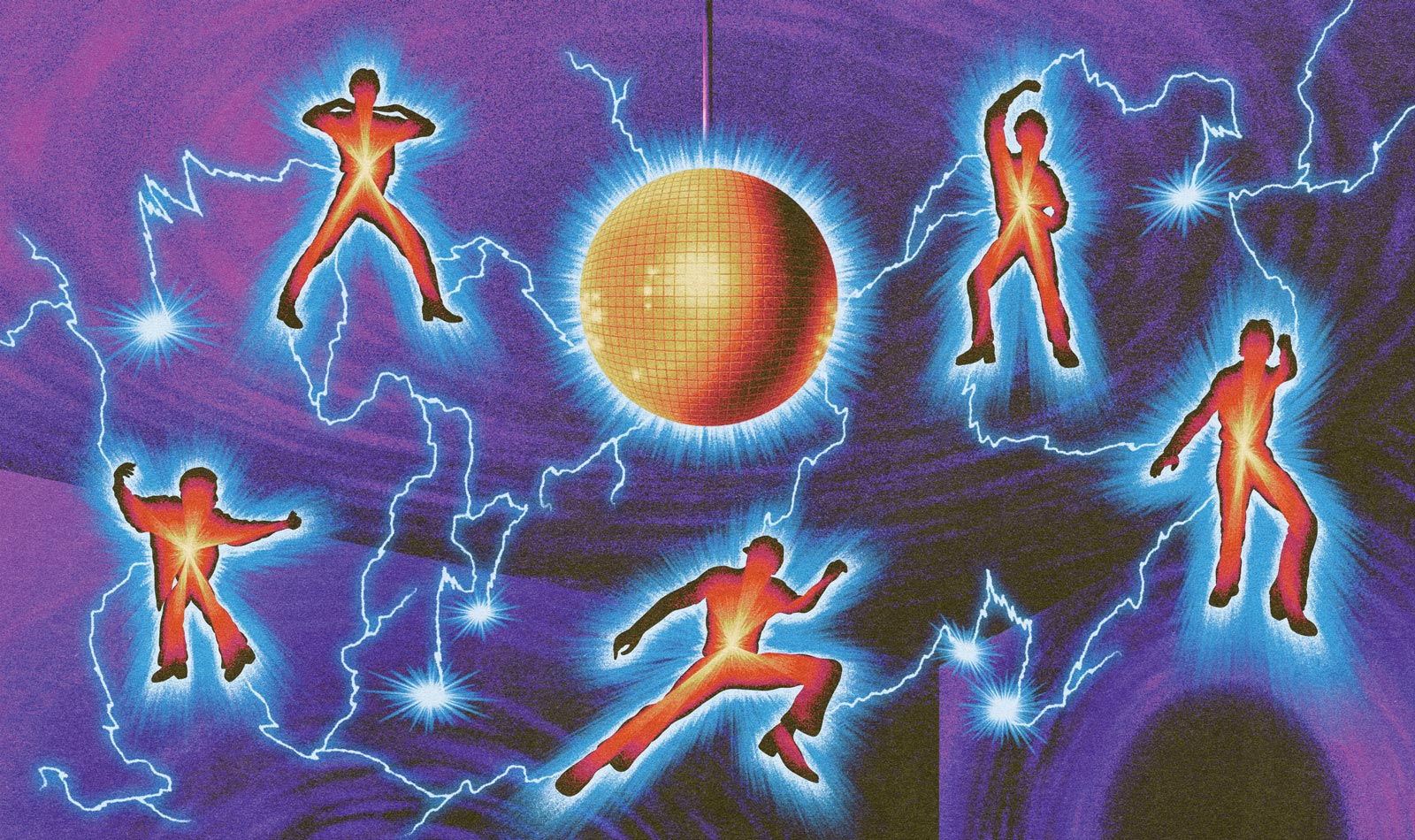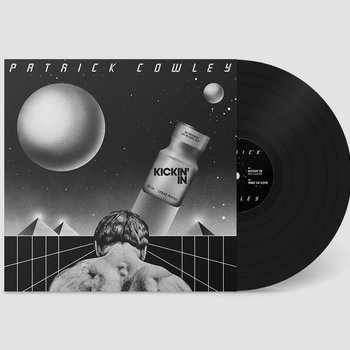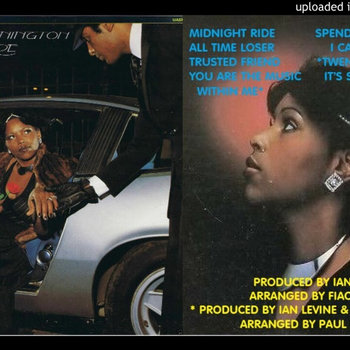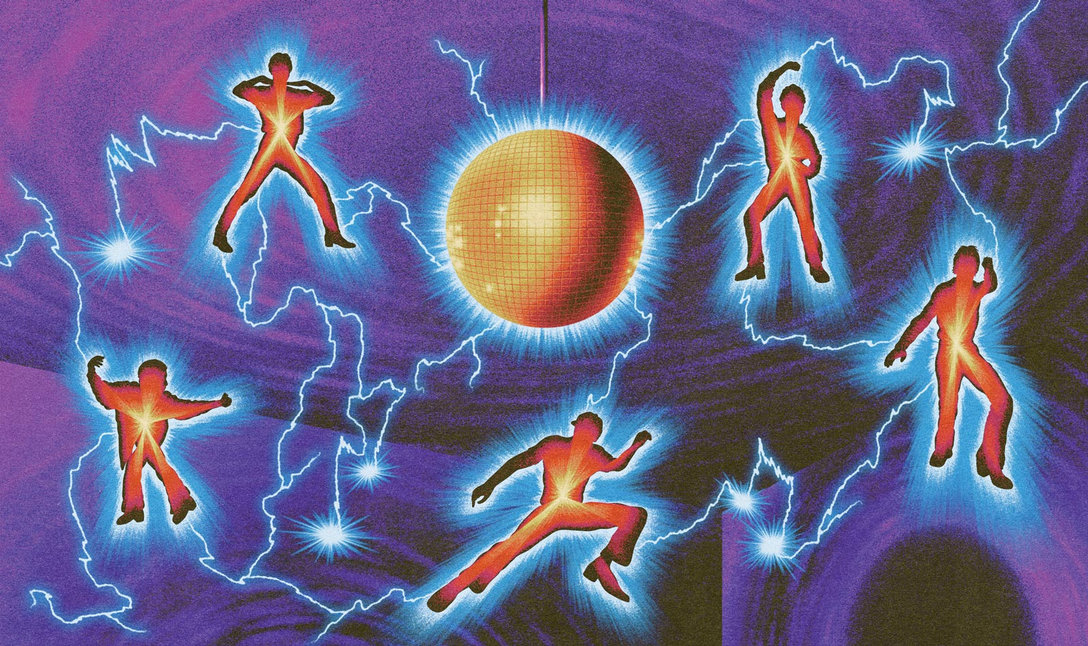Hi-NRG: How San Francisco’s Gay Bars Launched Disco’s Most Daring Era
By
·
Illustration by
·
October 20, 2025

As the dark cloud of AIDS hung over the gay community in the early to mid-‘80s, a new genre of electronic music exploded onto the club scene. This was Hi-NRG, powered by fast tempo four-on-the-floor rhythms, staccato hi hats, arpeggio synth riffs, octave basslines, and impassioned vocals.
Towards the end of the ‘70s the gay clubs of San Francisco had started moving to a different beat. “It began in places like the I-Beam and Endup where you’d hear higher BPM records like “Move On Up” by Destination, “Without Your Love” by Cut Glass, and Brainstorm’s “Lovin Is Really My Game,” says DJ Steve Fabus. “It wasn’t until the domination of synthesizers and electronic sounds that we called it Hi-NRG, though. Then in the ‘80s at clubs like Trocadero Transfer, it became the peak music. People wanted energy for longer periods before settling into the morning music.”
There was one record that pointed the way for disco’s electronic transition towards Hi-NRG. “Giorgio Moroder’s production of ‘I Feel Love’ by Donna Summer was a new sound incorporating electronic sound and synthesizers with a faster disco beat… It definitely was the foundation of Hi-NRG,” says Fabus, who span at many of San Francisco’s gay clubs during the Hi-NRG era.
In his essential book, Tribal Rites: The San Francisco Dance Music Phenomenon 1978-88, David Diebold wrote: “One of the most obvious and dominant factors in the emergence of dance music in San Francisco was the explosion onto the scene of the charismatic, daring record labels of the time.”
Megatone is the best known of those labels, founded in 1981 by producer Patrick Cowley with DJ/producer Marty Blecman. Pioneer of The San Francisco Sound who died tragically young as AIDS swept through his community, Cowley had arrived in San Francisco from Buffalo, New York, in 1971 at the age of 21. Originally a drummer, he became the most famous student of Gerald Mueller’s Electronic Music Lab at City College of San Francisco. Composing music all day and hitting the bathhouses and gay clubs by night, he became deeply immersed in the city’s clubs of the mid-’70s.
A regular hangout of Cowley’s was City Disco, which would become one of the incubators of the early Hi-NRG sound alongside Dreamland, the EndUp, I-Beam, and Trocadero Transfer, where Steve Fabus held down residencies. By 1978, Cowley had turned from clubber to employee when he was taken on as City Disco’s lighting technician. It was there he met club regular Sylvester, who was looking to take his soul rock act into a new direction.
They struck up a quick friendship and Cowley played the singer tracks he had been working on, including a 16-minute bootleg of Donner Summer’s “I Feel Love,” a version of which was uncovered by Dark Entries. They were soon in the studio together working on the monumental electronic proto Hi-NRG disco single “You Make Me Feel (Mighty Real)” as well as the subsequent album, 1978’s Step II. As London DJ/Producer of S’Express fame, Mark Moore, says: “Giorgio Moroder had set the blueprint for an electronic dance sound, but Patrick Cowley, through his work with Sylvester and his own productions, helped make Hi-NRG into a genre.”
City Disco also gave birth to another early Cowley production. One night, singer Frank Loverde, another victim of AIDS who passed away in 1990, was performing there with his band, Loverde. After the gig, Cowley invited them back to his studio. One of the tracks they worked on together was a drug-fuelled 10-minute version of Cerrone’s “Supernature,” appropriately titled “Kickin In’,” released by Dark Entries in 2024.
San Francisco, California

San Francisco, California
Hidden in the vaults at Megatone, “Kickin In”’ was discovered by John Hedges, aka Johnny “Disco” Hedges, the resident DJ at City Disco. In the late 1970s, he began a partnership with Marty Blecman, releasing records for the Fantasy label. Both Hedges and Blecman made the transition from disco to Hi-NRG, often working with producer Barry Beam (also known as Barry Blum). When Patrick Cowley passed in 1982, Hedges joined Blecman in steering the label into the peak Hi-NRG years.
Cowley and Blecman (who also died of AIDS related complications in 1991) had founded Megatone in the Summer of 1981 to release a project they had been working on. Foundational to the story of Hi-NRG, the Cowley and Blecman-produced Megatron Man album from 1981 dropped like a bomb in the clubs. As well as the title track, the album included “Lift Off,” the first collaboration between Cowley and the most prolific male vocalist of the genre.
Patrick Cowley had heard Paul Parker singing in a cover band and thought his voice would be perfect against a pulsating electronic backdrop. Released on Megatone in 1982, the Cowley-penned “Right on Target,” co-produced by Cowley and Marty Blecman, was one of Hi-NRG’s era-defining records. “You would hear it everywhere, but I always associate it with the I-Beam and Trocadero Transfer,” says Steve Fabus.
Cowley trialled his mixes at a new club he opened at the EndUp, known as Menergy. Sadly, his stunning 1982 album Mind Warp, produced during the depths of his illness, would be his goodbye: He passed away at the age of 32 on November 12th of that year. “Patrick Cowley is rightly celebrated as one of the major architects of the San Francisco Sound, especially in the way he presented electronic music,” says Fabus. “He is fondly remembered as the Giorgio Moroder of San Francisco, in a way that’s more personal because of how his music in many ways tells the story of gay life during that era.”
Megatone’s main label rival in San Francisco was an equally scene-connected indie by the name of Moby Dick. It began life as a platform for DJ Bil Motley’s Boys Town Gang. Founded in collaboration with Will Smith, Craig Morey, and Victor Swedosh (whose bar on Castro Street gave the label its name), its first release was Boy’s Town Gang’s version of “Ain’t No Mountain High Enough.”
Taken from their second album, 1981’s Disc Charge, “Disco Kicks” is an example of the Moby Dick sound, which reached its peak on throbbing, orgasmic, and darkly poppy dancefloor destroyers like the John Hedges/Barry Blum produced “‘Rocket To Your Heart” by Lisa and Loverde, or Patrick Cowley’s”‘Die Hard Lover.” Moby Dick was forced to shutter in 1984 due to insurmountable debt, replaced by the short-lived Pink Glove, label home to Magda Dioni’s “Dangerous.”
While San Francisco was undoubtedly the American capital of Hi-NRG, its other most influential and prolific producer was from New York. The resolutely straight Bobby Orlando (aka Bobby O) was, as writer Dennis Cooper explained, a complex contradiction: “Most of his songs are brazen odes to sex and partying, and yet he’s a fundamentalist Christian who penned a book on creationism called Darwin Destroyed.”
Raised in Westchester, New York State, Orlando grew up playing in teenage rock bands but found his way into the dance world. Inspired by Giorgio Moroder, he produced his first disco record in 1978—“Dancin’” by Tod Foster—leading to a job as in-house producer for Vanguard Records, which helped him set up his own label.
Orlando’s big breakthrough came when he was approached by drag film star Divine for the start of one of the more unlikely musical partnerships. Written by Bobby O, who played all instruments himself as he did on all of his productions,“Native Love” was their Hi-NRG masterpiece, a cowbell-infected slab of freaky electronic excess that reeked of poppers, sex, and sweat.
Bobby O produced and composed hundreds of his distinctive cowbell-heavy productions for a vast array of his own labels, the most prolific being Bobcat Records, Memo Records, and Eurobeat Records As well as the Pet Shop Boys, who searched him out in New York to produce their first singles, New Order took notes of Bobby O’s productions while immersing themselves in Manhattan’s clubs. Things came full circle when Bobby O lifted the bassline of “Blue Monday” for Divine’s “Love Reaction.”

Like Sylvester, Divine played legendary gigs at London club Heaven, which had become a kind of epicenter for Hi-NRG in the UK thanks to resident DJ Ian Levine. Across the mid-‘70s, Levine took Northern Soul into the modern era, spinning at Blackpool Mecca while also getting deep into disco during visits to New York clubs. He moved into production in 1976, recording with American soul artists like The Exciters and Barbara Pennington.
Together with his long-term songwriting partner Fiachra Trench, Levine worked out of the famous Trident Studios in London. Recorded in 1979 with the Chicago-based Susan Wells, but unreleased at the time, “Nightmare” was a proto Hi-NRG stomper (check those cowbells) that anticipated his famous Trident Studios productions with singers Miquel Brown, Earlene Bentley and Evelyn Thomas.
The initial label home of these Hi-NRG stars was Record Shack, which Levine operated in collaboration with the record shop of the same name. After leaving Record Shack in 1986, Levine set up his Nightmare label that took its name from the Susan Wells track.
Throughout the early to mid-’80s, Heaven became the testing ground for Levine’s Hi-NRG productions, inspired by his visits to The Saint in New York. This included his biggest seller, Miquel Brown’s “So Many Men, So Little Time,” recorded during the early hours at Trident Studios after Levine’s set at Heaven. Released on Record Shack in 1983, it was also one of several Levine productions that became anthems in America’s gay clubs.
Recalling hearing “So Many Men, So Little Time” at The Saint for the first time, Levine told writer Bill Brewster: “Three in the morning, at the peak of the night. He [DJ Robbie Leslie] stopped the last record dead, plunged the room into blackness, and then there was boo-boo-boo-boo-boo-boom. And by Monday, it was the talk of New York.”
The UK was now awash with labels supporting the Hi-NRG boom, the most high-profile being Record Shack, Passion, Proto, Bolts, and ERC. Simultaneously, UK groups like Frankie Goes to Hollywood, The Communards, and Dead or Alive (one of many Hi-NRG-influenced groups produced by Bobby O imitators Stock, Aitken & Waterman) pounded out their own poppy takes on the sounds heard at Heaven.
Mark Moore was just one of those who had become disillusioned with the musical direction in many of the gay clubs by the mid-’80s. “The Hi-NRG sound had gotten really watered down and very generic by this time, and we were bored of it,” he says. His response was a new night at Heaven called Pyramid, founded with fellow pioneering DJ Colin Faver. “Our sets were madder and more eclectic than the regular nights at Heaven, and the Chicago house and Detroit techno just slotted in really easily,” he says.
As acid house swept across the UK, Ian Levine left his long residency at Heaven in 1989, a year after The Saint in New York closed its doors. The golden age of Hi-NRG in San Francisco had also come to an end, accelerated by the loss of many of the original producers and label owners to AIDS.
Ultimately, it was the arrival of house music and subsequently trance that pushed Hi-NRG out of the clubs. But the music and messages had left an indelible mark. “A major part of the legacy of Hi-NRG is that it was music that was created by gay artists for the gay club culture,” says Steve Fabus. “Through these records like ‘So Many Men, So Little Time,’ ‘Menergy,’ and ‘Take Me To Heaven,’ the dancers heard music speaking directly to them.”
Read on for more peak-time Hi-NRG anthems.
Patrick Cowley
Malebox
San Francisco, California
San Francisco, California
Dark Entries has worked with Patrick Cowley’s friends and family to uncover more of his unreleased dancefloor productions. Recorded between 1979 and 1981, the six tracks on Malebox included the blistering Paul Parker proto Hi-NRG demos “If You Feel It” and “Love Me Hot.” Released on the 40th anniversary of Cowley’s passing on November 12th, 2022, it was a fitting tribute to his genius as a composer, orchestrator, and producer.
The Flirts
“Passion”
No other producer had as many concepts and monikers as Bobby O. Like the Phil Spector of Hi-NRG, he put together the New York girl group The Flirts in 1982. As darkly poppy as it was wonderfully sleazy, “Passion” was their big hit in the clubs and charts across Europe in 1982, a classic piece of synth-pop that Bobby O followed up with the 10¢ A Dance album on “O” Records.
Bobby O
“Make It On My Own” (Ben Liebrand Remix)
Bobby O went by a dizzying array of aliases for solo and group projects, including Barbie & The Kens, Darlene Down, Girls Have Fun, Bubba & The Jack Attack, Gringo Lopez, and Hippies With Haircuts. Next to The Flirts, his best known and most successful was Free Enterprise, featuring Wendell Morrison of Inner Life, with whom he also recorded as 1 Plus 1. One of Bobby O’s greatest compositions, “Make it On My Own” straddles disco and Hi-NRG to dancefloor-destroying effect.
Divine
“Shake It Up” (Original 12″ Mix)
Next to “Native Love” and “Love Reaction,” Divine’s biggest Hi-NRG hit was the thunderous “Shake It Up.” While Bobby O is often derided for his magpie tendencies in borrowing from other records, there’s no denying his genius as a writer, producer, and musician. And ‘Shake It Up’ was one of his greatest works; a mighty slab of synth-driven, cowbell-clattering Hi-NRG with Divine in fierce form.
Tantra
“The Hills of Katmandu” (Lime Remix)
There were many Italo disco records that crossed over into Hi-NRG. The prolific songwriter, arranger, and producer, Celso Valli was behind some of the biggest. “My favorite Italo Hi-NRG record of all time is ‘The Hills of Katmandu’ by Tantra,” says Steve Fabus. “It’s a 16-minute trip record that never lets up. Patrick Cowley did a remix of the record as well. I prefer the original. The record had a cult following at the Trocadero and The Saint.”
Passengers
“Hot Leather”
Celso Valli also founded Passengers with singer Kim Arena and producers Angelo & Felix Piccarreda. After the success of “The Hills of Katmandu,” his next project was picked up by Moby Dick for this sleazy and steamy 1981 release. “Hot Leather” got the Moby Dick remix treatment through Craig Morey and friends.
Astaire
“Love Trap”
Astaire was the stage name of session singer Tracy Ackerman, who had a number of Hi-NRG hits for Passion, “‘Love Trap” being the biggest hit. It was one of a raft of Passion 12-inches mixed by Ian Anthony Stephens, who worked alongside Paul Parker through the ‘80s into the ‘90s. Other big Hi-NRG 12-inches for Passion included the Levine and Trench–produced “Landslide” by Croisette and a string of 12-inches with Levine’s relaunched Eastbound Expressway.
Lime
“I Don’t Want to Lose You”
The other city most associated with Hi-NRG was Montreal, thanks to the many electronic disco records released on the Matra label. Home to Hi-NRG hits like Carol Jiani’s “Hit ‘N Run Lover” and Vera’s “‘Don’t You Want My Love,” it became the platform for one of Hi-NRG’s most successful groups. The work of husband and wife Denis and Denys LePage, Lime recorded seven LPs of euphoric Hi-NRG for Matra between 1981 and 1986.
Paul Parker
Strong – The Album
Best known for producing Hazel Dean’s “Searchin’” from 1983, remixed by Ian Levine, Ian Anthony Stephens formed the group Fantasia with Paul Parker for the 1983 Hi-NRG gem “Evergreen” for Passion. His label of the same name debuted with Paul Parker’s “Without Your Love” in 1984, followed by a string of Hi-NRG releases. This 2025 album saw Parker and Stephens rework some of the singer’s biggest Hi-NRG hits.

